2016高考英语阅读考试大纲要求【解析批注版】
2016高考英语阅读考试大纲要求【解析批注版】
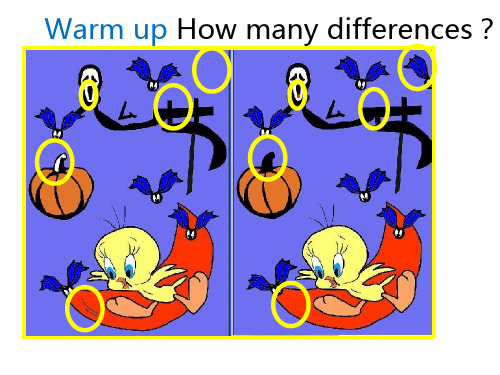
一句话说明:这是高考的最高王法! 谁都不能违背!
功能在于说明: 1、考什么? 2、怎么考?
2016高考全国新课标卷英语考试说明和考试大纲 英语考试大纲
要求考生能读懂书、报、杂志中关于一般 性话题的简短文段以及公告、说明、广告等, 并能从中获取相关信息。考生应能: (1)理解主旨和要义 (2)理解文中具体信息 (3)根据上下文推断生词的词义 (4)作出判断和推理 (5)理解文章的基本结构 (6)理解作者的意图、观点和态度
(英语考试大纲 5)理解文章的基本结构
英语文章讲究使用主题段和主题句。 主题段通常在文章开头,简要概括文章的中心 思想。 主题句可能在一段的开头,也可能在中间或末 尾,作用是交代该段的中心思想,再由全段展开或 讨论这个意思。 各个段落通常由某些起连接作用的词语连接, 以使文章行文连贯。如果希望准确、深刻地理解一 篇文章,必须对文章的结构有所了解,把握住全篇 的文脉,即句与句、段与段之间的逻辑关系。
命 题 类
主 旨 大 意 型 事 实 细 节 型
词 义 猜 测 型 推 理 判 断 型
Warm up How many differences?
Reading is everything!
Why?
什么是考试大纲? 英语考试大纲
(2)理解文中具体信息 (3)根据上下文推断生词的词义 (4)作出判断和推理 (5)理解文章的基本结构 (6)理解作者的意图、观点和态度
什么是考试大纲? 英语考试大纲
(3)根据上下文推断单词和短语的含义 英语考试大纲
正确理解文章中单词或短语的含义是理解文章 的第一步,也是理解文章的基础,不懂单词含义根 本就谈不上理解文章。但英语单词的含义并非完全 等同于词典中所标注的汉语意思,其含义随不同的 语境会有所不同。(注:语境为王)能根据上下文 正确理解灵活变化的词义,才算是真正初步具备了 一定的阅读理解能力。此外,阅读文章时,常常会 遇到一些过去未见过的词,但许多这类生词的词义 可以通过上下文推断出来。这种不使用词典而通过 阅读上下文来推断生词含义的能力,是一个合格的 读者必须具备的能力,因此也是阅读测试中经常检 测的一种能力。
2016年重庆高考英语大纲解析及复习指导
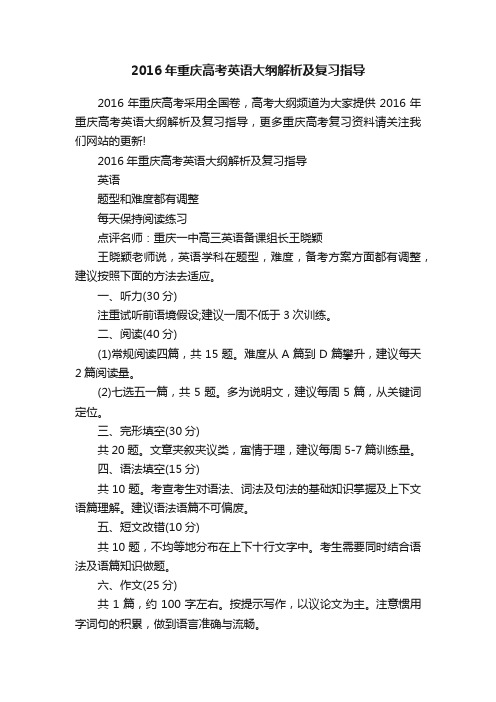
2016年重庆高考英语大纲解析及复习指导
2016年重庆高考采用全国卷,高考大纲频道为大家提供2016年重庆高考英语大纲解析及复习指导,更多重庆高考复习资料请关注我们网站的更新!
2016年重庆高考英语大纲解析及复习指导
英语
题型和难度都有调整
每天保持阅读练习
点评名师:重庆一中高三英语备课组长王晓颖
王晓颖老师说,英语学科在题型,难度,备考方案方面都有调整,建议按照下面的方法去适应。
一、听力(30分)
注重试听前语境假设;建议一周不低于3次训练。
二、阅读(40分)
(1)常规阅读四篇,共15题。
难度从A篇到D篇攀升,建议每天2篇阅读量。
(2)七选五一篇,共5题。
多为说明文,建议每周5篇,从关键词定位。
三、完形填空(30分)
共20题。
文章夹叙夹议类,寓情于理,建议每周5-7篇训练量。
四、语法填空(15分)
共10题。
考查考生对语法、词法及句法的基础知识掌握及上下文语篇理解。
建议语法语篇不可偏废。
五、短文改错(10分)
共10题,不均等地分布在上下十行文字中。
考生需要同时结合语法及语篇知识做题。
六、作文(25分)
共1篇,约100字左右。
按提示写作,以议论文为主。
注意惯用字词句的积累,做到语言准确与流畅。
2016年高考天津卷英语试题解析(精编版)(解析版)
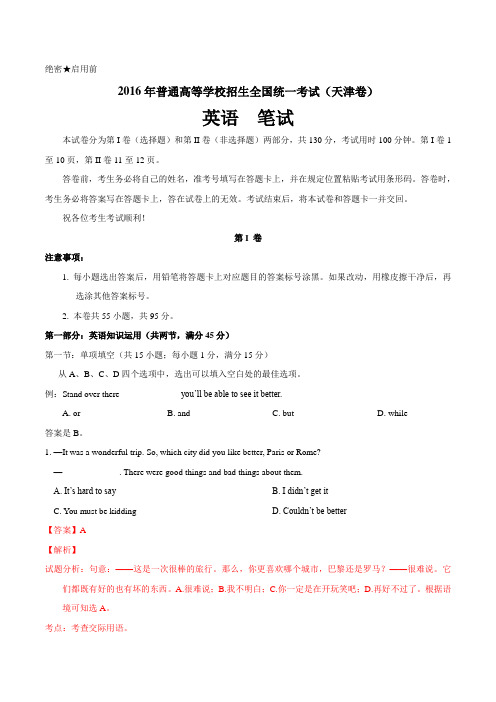
绝密★启用前2016年普通高等学校招生全国统一考试(天津卷)英语笔试本试卷分为第I卷(选择题)和第II卷(非选择题)两部分,共130分,考试用时100分钟。
第I卷1至10页,第II卷11至12页。
答卷前,考生务必将自己的姓名,准考号填写在答题卡上,并在规定位置粘贴考试用条形码。
答卷时,考生务必将答案写在答题卡上,答在试卷上的无效。
考试结束后,将本试卷和答题卡一并交回。
祝各位考生考试顺利!第I 卷注意事项:1. 每小题选出答案后,用铅笔将答题卡上对应题目的答案标号涂黑。
如果改动,用橡皮擦干净后,再选涂其他答案标号。
2. 本卷共55小题,共95分。
第一部分:英语知识运用(共两节,满分45分)第一节:单项填空(共15小题;每小题1分,满分15分)从A、B、C、D四个选项中,选出可以填入空白处的最佳选项。
例:Stand over there _____________ you’ll be able to see it better.A. orB. andC. butD. while答案是B。
1. —It was a wonderful trip. So, which city did you like better, Paris or Rome?—_____________. There were good things and bad things about them.A. It’s hard to sayB. I didn’t get itC. You must be kiddingD. Couldn’t be better【答案】A【解析】试题分析:句意:——这是一次很棒的旅行。
那么,你更喜欢哪个城市,巴黎还是罗马?——很难说。
它们都既有好的也有坏的东西。
A.很难说;B.我不明白;C.你一定是在开玩笑吧;D.再好不过了。
根据语境可知选A。
考点:考查交际用语。
2. The dictionary is _____________: many words have been added to the language since it was published.A. out of controlB. out of dateC. out of sightD. out of reach【答案】B考点:考查介词短语。
2016年浙江高考英语大纲解读及备考建议
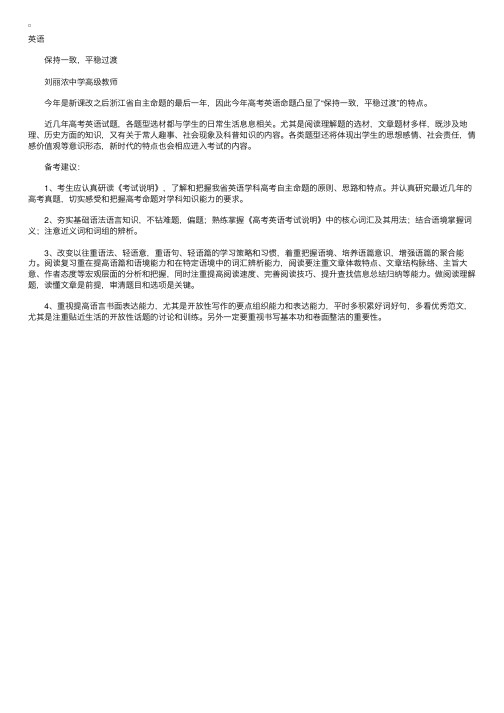
英语
保持⼀致,平稳过渡
刘丽浓中学⾼级教师
今年是新课改之后浙江省⾃主命题的最后⼀年,因此今年⾼考英语命题凸显了“保持⼀致,平稳过渡”的特点。
近⼏年⾼考英语试题,各题型选材都与学⽣的⽇常⽣活息息相关。
尤其是阅读理解题的选材,⽂章题材多样,既涉及地理、历史⽅⾯的知识,⼜有关于常⼈趣事、社会现象及科普知识的内容。
各类题型还将体现出学⽣的思想感情、社会责任,情感价值观等意识形态,新时代的特点也会相应进⼊考试的内容。
备考建议:
1、考⽣应认真研读《考试说明》,了解和把握我省英语学科⾼考⾃主命题的原则、思路和特点。
并认真研究最近⼏年的⾼考真题,切实感受和把握⾼考命题对学科知识能⼒的要求。
2、夯实基础语法语⾔知识,不钻难题,偏题;熟练掌握《⾼考英语考试说明》中的核⼼词汇及其⽤法;结合语境掌握词义;注意近义词和词组的辨析。
3、改变以往重语法、轻语意,重语句、轻语篇的学习策略和习惯,着重把握语境、培养语篇意识,增强语篇的聚合能⼒。
阅读复习重在提⾼语篇和语境能⼒和在特定语境中的词汇辨析能⼒,阅读要注重⽂章体裁特点、⽂章结构脉络、主旨⼤意、作者态度等宏观层⾯的分析和把握,同时注重提⾼阅读速度、完善阅读技巧、提升查找信息总结归纳等能⼒。
做阅读理解题,读懂⽂章是前提,审清题⽬和选项是关键。
4、重视提⾼语⾔书⾯表达能⼒,尤其是开放性写作的要点组织能⼒和表达能⼒,平时多积累好词好句,多看优秀范⽂,尤其是注重贴近⽣活的开放性话题的讨论和训练。
另外⼀定要重视书写基本功和卷⾯整洁的重要性。
2016年高考全国卷英语阅读理解第一节题型分析及备考建议
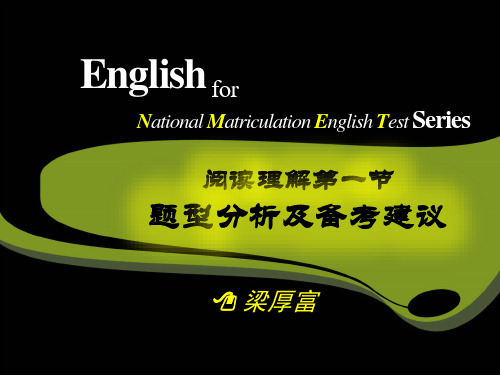
NMET Series
© Howard Liang
篇幅长度(与原广东卷相比)
年份 2012年 1072/1315 268/328.8 71.5/65.8 30.4/32.9
体裁类型
总字数
篇均字数 题均字数 分均字.3/330.5
75/66.1 33.3/33.1
实例分析1
2015 D
NMET Series
© Howard Liang
1
Conflict is on the menu tonight at the café La Chope. This evening, as on every Thursday night, psychologist Maud Lehanne is leading two of France’s favorite pastimes, coffee drinking and the “talking cure”. Here they are learning to get in touch with their true feelings. It isn’t always easy. The customers — some thirty Parisians who pay just under $2 (plus drinks) per session — are quick to intellectualize (高谈阔论), slow to open up and connect. “You are forbidden to say ‘one feels,’ or ‘people think’,” Lehane told them. “Say ‘I think,’ ‘Think me’.”
2016高考英语考纲解读课

“新课标”(全国卷) 阅读总量
年份
试卷总词汇量
变化
2011
3358
2012
3355
-3
2013 2014卷I 2014卷II 2015卷I
3273 3109 3163
3190
-82 -164
-110 +32
全国卷的特点
近三年试卷特别注意对中国传统文化、优秀 资源的宣传和弘扬。建议考生备考时掌握各 应用类信件的书写要领,如邀请函、自荐信、 感谢信、道歉信等,并熟悉 各种相关的体裁 和句式;内容上体现文明、和谐、诚信、友 善等主题的题材,以及传播优秀传统文化的 话题,如游览名胜、民俗节日等;会用英文 描写传统文化。
第二部分 阅读理解 第一节 阅读理解
(15小题,30分) 第二节 七选五
(5小题,10分 ) 第三部分 语言知识运用 第一节 完形填空
(20小题,30分)
第二节 语法填空 (10小题,15分) 第四部分 写作
第一节 短文改错 (10小题,10分)
第二节书面表达 (1题,25分)
听、读、写能力考查密切相 连,所有题型考查语境均提 高到了“篇章层次”。
年份
2013 2014 2015
听力音频
词数
累计时间 平均语速
第一节 第二节 合计 (一遍) (词/分)
177
668 845 5'16"
160
147
724 871 5′59″
146
152
748 900 5′51″
154
1. 语速:154词/分(比2014年快) 2. 录音稿总词数:900词(比2014年多) 3. 语音:美音 (没变) 4. 录音人:Kris, Laura (没变)
2016全国高考英语试题及答案解析全国卷.doc
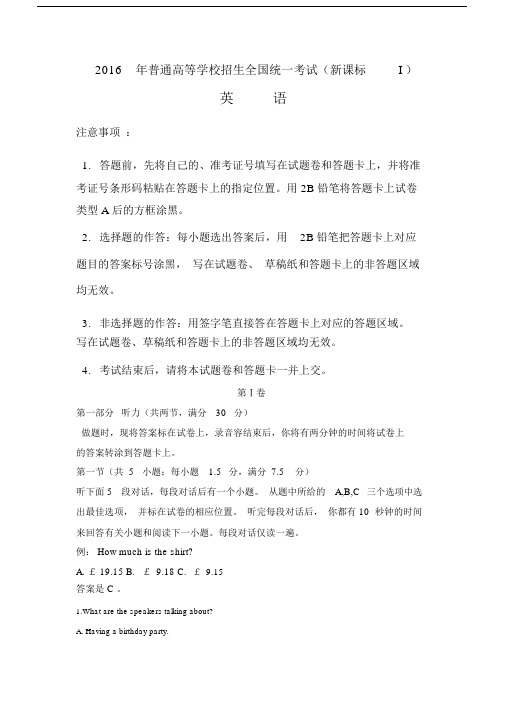
2016 年普通高等学校招生全国统一考试(新课标I )英语注意事项:1.答题前,先将自己的、准考证号填写在试题卷和答题卡上,并将准考证号条形码粘贴在答题卡上的指定位置。
用 2B 铅笔将答题卡上试卷类型 A 后的方框涂黑。
2.选择题的作答:每小题选出答案后,用 2B 铅笔把答题卡上对应题目的答案标号涂黑,写在试题卷、草稿纸和答题卡上的非答题区域均无效。
3.非选择题的作答:用签字笔直接答在答题卡上对应的答题区域。
写在试题卷、草稿纸和答题卡上的非答题区域均无效。
4.考试结束后,请将本试题卷和答题卡一并上交。
第Ⅰ卷第一部分听力(共两节,满分30分)做题时,现将答案标在试卷上,录音容结束后,你将有两分钟的时间将试卷上的答案转涂到答题卡上。
第一节(共 5小题;每小题 1.5分,满分7.5分)听下面 5段对话,每段对话后有一个小题。
从题中所给的A,B,C三个选项中选出最佳选项,并标在试卷的相应位置。
听完每段对话后,你都有 10 秒钟的时间来回答有关小题和阅读下一小题。
每段对话仅读一遍。
例: How much is the shirt?A. £ 19.15B.£9.18C.£9.15答案是 C 。
1.What are the speakers talking about?A. Having a birthday party.B. Doing some exercise.C. Getting Lydia a gift2.What is the woman going to do?A. Help the man.B. Take a bus.C.Get a camera3.What does the woman suggest the man do?A. Tell Kate to stop.B. Call Kate,s friends.C. Stay away from Kate.4.Where does the conversation probably take place?A. In a wine shop.B. In a supermarket.C. In a restaurant.5.What does the woman mean?A. Keep the window closed.B. Go out for fresh air.C. Turn on the fan.听第 6 段材料,回答第6、 7 题。
2016年全国卷英语分析——阅读理解和完形填空

2016年高考英语课标I卷阅读理解、完形填空精要解析从总体上看,2016年高考英语试卷难度略有提升,过度较为平稳。
试题重点突出,命题思路清晰,重视对思维能力和文化素质的考查,重点考查英语运用能力。
阅读理解与前几年的出题思路一致。
话题贴近学生生活,可读性强。
从体裁上看,稍有变化。
几乎年年出现的应用文今年没有考查。
从题目上来看,细节题居多。
15道阅读题里,1道主旨大意题,1道词义猜测题,2道推理判断题,11道事实细节题。
七选五秉承一贯特色,选用了说明文,结构清晰。
完形填空选自国外网站的一篇文章。
体裁依然是多年的夹叙夹议。
从题目上来看,文章内容看似简单,但选项中“陷阱”重重。
比如第41题应选择C选项traveling,但是很多学生选择了B选项touring,这体现出学生对一些基本词汇的深层含义的掌握是有欠缺的。
维克多英语编辑部认真研究2016年高考英语全国课标I卷,并对阅读理解的每篇文章和完形填空做了详尽的分析,包括语篇的话题、体裁、词数、难度、难点词、搭配、长难句等,并首次运用图式理论从关键词、背景、结构、内容、百科知识的角度分析了语篇,在答案解析部分呈现。
试卷导航第二部分阅读理解(共两节,满分40分)第一节(共15小题;每小题2分,满分30分)阅读下列短文,从每题所给的四个选项(A、B、C和D)中选出最佳选项,并在答题卡上将该项涂黑。
AYou probably know who Marie Curie was, but you may not have heard of Rachel Carson. Of the outstanding ladies listed below, who do you think was the most important woman of the past 100 years?Jane Addams (1860-1935)Anyone who has ever been helped by a social worker has Jane Addams to thank. Addams helped the poor and worked for peace. She encouraged a sense of community (社区) by creating shelters and promoting education and services for people in need. In 1931, Addams became the first American woman to win the Nobel Peace Prize.Rachel Carson (1907-1964)If it weren’t for Rachel Carson, the environmental movement might not exist today. Her popular 1962 book Silent Spring raised awareness of the dangers of pollution and the harmful effects of chemicals on humans and on the world’s lakes and oceans.Sandra Day O’Connor (1930-present)When Sandra Day O’Connor finished third in her class at Stanford Law School, in 1952, she could not find work at a law firm because she was a woman. She became an Arizona state senator (参议员) and, in 1981, the first woman to join the U.S. Supreme Court. O’Connor gave the deciding vote in many important cases during her 24 years on the top court.Rosa Parks (1913-2005)On December 1, 1955, in Montgomery, Alabama, Rosa Parks would not give up her seat on a bus to a white passenger. Her simple act landed Parks in prison. But it also set off the Montgomery bus boycott. It lasted for more than a year, and kicked off the civil-rights movement. “The only tired I was, was tired of giving in,” said Parks.21. What is Jane Addams noted for in history?A. Her social work.B. Her teaching skills.C. Her efforts to win a prize.D. Her community background.22. What was the reason for O’Connor’s being rejected by the law firm?A. Her lack of proper training in law.B. Her little work experience in court.C. The discrimination against women.D. The poor financial conditions.23. Who made a great contribution to the civil-rights movement in the U.S.?A. Jane Addams.B. Rachel Carson.C. Sandra Day O’Connor.D. Rosa Parks.24. What can we infer about the women mentioned in the text?A. They are highly educated.B. They are truly creative.C. They are pioneers.D. They are peace-lovers.BGrandparents Answer a CallAs a third-generation native of Brownsville, Texas, Mildred Garza never planned to move away. Even when her daughter and son asked her to move to San Antonio to help with their children, she politely refused. Only after a year of friendly discussion did Ms. Garza finally say yes. That was four years ago. Today all three generations regard the move as a success, giving them a closer relationship than they would have had in separate cities.No statistics show the number of grandparents like Garza who are moving closer to adult children and grandchildren. Yet there is evidence suggesting that the trend is growing. Even President Obama’s mother-in-law, Marian Robinson, has agreed to leave Chicago and move into the White House to help care for her granddaughters. According to a study by , 83 percent of the people said Mrs. Robinson’s decision will influence grandparents in the American family. Two-thirds believe more families will follow the example of Obama’s family.“In the 1960s we were all a little wild and couldn’t get away from home far enough or fast enough to prove we could do it on our own,” says Christine Crosby, publisher of Grand, a magazine for grandparents. “We now realize how important family is and how important it is to be near them, espe cially when you’re raising children.”Moving is not for everyone. Almost every grandparent wants to be with his or her grandchildren and is willing to make sacrifices, but sometimes it is wiser to say no and visit frequently instead. Having your grandchildren far away is hard, especially knowing your adult child is struggling, but giving up the life you know may be harder.25. Why was Garza’s move a success?A. It strengthened her family ties.B. It improved her living conditions.C. It enabled her to make more friends.D. It helped her know more new places.26. What was the reaction of the public to Mrs. Robinson’s decision?A. 17% expressed their support for it.B. Few people responded sympathetically.C. 83% believed it had a bad influence.D. The majority thought it was a trend.27. What did Crosby say about people in the 1960s?A. They were unsure of themselves.B. They were eager to raise more children.C. They wanted to live away from their parents.D. They had little respect for their grandparents.28. What does the author suggest the grandparents do in the last paragraph?A. Make decisions in the best interests of their own.B. Ask their children to pay more visits to them.C. Sacrifice for their struggling children.D. Get to know themselves better.CI am Peter Hodes, a volunteer stem cell courier. Since March 2012, I’ve done 89 trips — of those, 51 have been abroad. I have 42 hours to carry stem cells (干细胞) in my little box because I’ve got two ice packs and that’s how long they last. In all, from the time the stem cells are harvested from a donor (捐献者) to the time they can be implanted in the patient, we’ve got 72 hours at most. So I am always conscious of time.I had one trip last year where I was caught by a hurricane in America. I picked up the stem cells in Providence, Rhode Island, and was meant to fly to Washington then back to London. But when I arrived at the check-in desk at Providence, the lady on the desk said: “Well, I’m really sorry, I’ve got some bad news for you —there are no flights from Washington.” So I took my box and put it on the desk and I said: “In this box are some stem cells that are urgently needed for a patient —please, please, you’ve got to get me back to the United Kingdom.” She just dropped everything. She arranged for a flight on a small plane to be held for me, re-routed (改道) me through Newark and got me back to the UK even earlier than originally scheduled.For this courier job, you’re consciously aware that in that box you’ve got something that is potentially going to save somebody’s life.29. Which of the following can replace the underlined word “courier” in Paragraph 1?A. providerB. delivery manC. collectorD. medical doctor30. Why does Peter have to complete his trip within 42 hours?A. He cannot stay away from his job too long.B. The donor can only wait for that long.C. The operation needs that much time.D. The ice won’t last any longer.31. Which flight did the woman put Peter on first?A. To London.B. To Newark.C. To Providence.D. To Washington.DThe meaning of silence varies among cultural groups. Silences may be thoughtful, or they may be empty when a person has nothing to say. A silence in a conversation may also show stubbornness, uneasiness, or worry. Silence may be viewed by some cultural groups as extremely uncomfortable; therefore attempts may be made to fill every gap (间隙) with conversation. Persons in other cultural groups value silence and view it as necessary for understanding a person’s needs.Many Native Americans value silence and feel it is a basic part of communicating among people, just as some traditional Chinese and Thai persons do. Therefore, when a person from oneof these cultures is speaking and suddenly stops, what may be implied (暗示) is that the person wants the listener to consider what has been said before continuing. In these cultures, silence is a call for reflection.Other cultures may use silence in other ways, particularly when dealing with conflicts among people or in relationships of people with different amounts of power. For example, Russian, French, and Spanish persons may use silence to show agreement between parties about the topic under discussion. However, Mexicans may use silence when instructions are given by a person in authority rather than be rude to that person by arguing with him or her. In still another use, persons in Asian cultures may view silence as a sign of respect, particularly to an elder or a person in authority.Nurses and other care-givers need to be aware of the possible meanings of silence when they come across the personal anxiety their patients may be experiencing. Nurses should recognize their own personal and cultural construction of silence so that a patient’s silence is not interrupted too early or allowed to go on unnecessarily. A nurse who understands the healing (治愈) value of silence can use this understanding to assist in the care of patients from their own and from other cultures.32. What does the author say about silence in conversations?A. It implies anger.B. It promotes friendship.C. It is culture-specific.D. It is content-based.33. Which of the following people might regard silence as a call for careful thought?A. The Chinese.B. The French.C. The Mexicans.D. The Russians.34. What does the author advise nurses to do about silence?A. Let it continue as the patient pleases.B. Break it while treating patients.C. Evaluate its harm to patients.D. Make use of its healing effects.35. What may be the best title for the text?A. Sound and SilenceB. What It Means to Be SilentC. Silence to Native AmericansD. Speech Is Silver, Silence Is Gold第二节(共5小题;每小题2分,满分10分)根据短文内容,从短文后的选项中选出能填入空白处的最佳选项。
2016年全国卷高考英语精彩试题及问题详解 全国卷1
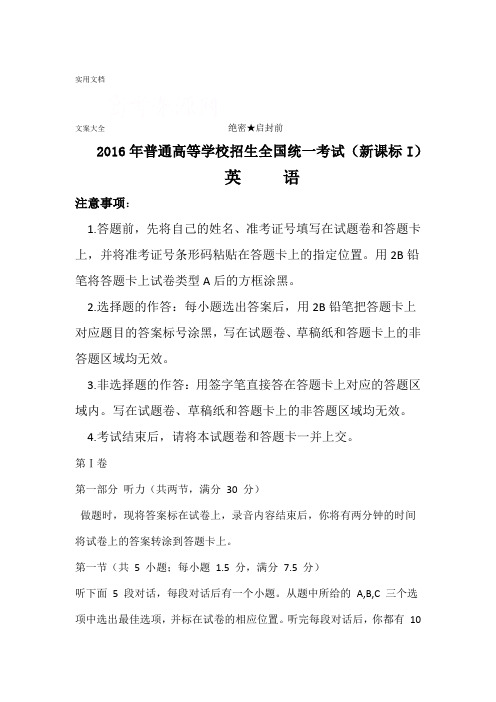
实用文档文案大全绝密★启封前2016年普通高等学校招生全国统一考试(新课标I)英语注意事项:1.答题前,先将自己的姓名、准考证号填写在试题卷和答题卡上,并将准考证号条形码粘贴在答题卡上的指定位置。
用2B铅笔将答题卡上试卷类型A后的方框涂黑。
2.选择题的作答:每小题选出答案后,用2B铅笔把答题卡上对应题目的答案标号涂黑,写在试题卷、草稿纸和答题卡上的非答题区域均无效。
3.非选择题的作答:用签字笔直接答在答题卡上对应的答题区域内。
写在试题卷、草稿纸和答题卡上的非答题区域均无效。
4.考试结束后,请将本试题卷和答题卡一并上交。
第Ⅰ卷第一部分听力(共两节,满分30 分)做题时,现将答案标在试卷上,录音内容结束后,你将有两分钟的时间将试卷上的答案转涂到答题卡上。
第一节(共 5 小题;每小题 1.5 分,满分7.5 分)听下面5 段对话,每段对话后有一个小题。
从题中所给的A,B,C 三个选项中选出最佳选项,并标在试卷的相应位置。
听完每段对话后,你都有10秒钟的时间来回答有关小题和阅读下一小题。
每段对话仅读一遍。
1.What are the speakers talking about? A. Having a birthday party. B. Doing some exercise.C. Getting Lydia a gift实用文档文案大全2. What is the woman going to do? A. Help the man. B. Take a bus.C. Get a camera3. What does the woman suggest the man do? A. Tell Kate to stop. B. Call Kate, s friends. C. Stay away from Kate.4. Where does the conversation probably take place? A. In a wine shop. B. In a supermarket.C. In a restaurant.5. What does the woman mean? A. Keep the window closed. B. Go out for fresh air.C. Turn on the fan.听第6段材料,回答第6、7题。
2016年高考英语新课标卷考纲解读及备考启示

2016年高考英语新课标卷考纲解读及备考启示安溪八中陈水生一2016年的考纲2015年相比有三个变化:1.词汇量变化为3000-3500。
因此加强词汇识记应该说增强阅读能力的基础和关键。
词汇量的积累应该列为贯穿于高考复习全过程的首要任务。
实际情况是新课标卷实际单词考察量只是略高于大纲卷,这是由于每年都有新省份加入而必须保持过渡性、稳定性。
2.增加阅读中对词义推断的要求。
把“根据上下文推断生词的词义”改为“根据上下文推断单词和短语的含义”。
由此看出考试中“词语猜测题”的难度会加大,尤其会加大考生对单词和短语在具体语境中特殊含义的考查力度。
例如:“一词多义”的问题。
学生在运用英语的过程中,经常会遇到十分眼熟的词,但是看不懂意思。
例如:高考试题中曾经出现a state-run company,许多同学完全不懂,既不知道state的含义,也不知道run的含义。
“一词多义”的现象是一种语言表达力丰富的标志,也是我们不可回避的重点。
3.改变语法填空题中所填词数的要求。
把“在空白处填入适当的内容(不多于3个单词)或括号内单词的正确形式” 改为“在空白处填入适当的内容(1个单词)或括号内单词的正确形式”。
二2016年高考英语备考启示。
(一)阅读理解备考启示:在复习中应着重加大语篇分析的训练,提高学生语篇分析能力和语言的综合运用能力,要精选一些短文阅读试题进行渐进式的强化练习,注重做题时间的控制和阅读速度的定量提高。
从练入手强化知识的运用,从分析入手注重能力的提高,从结果入手寻找适应的差距。
要尽可能使自己始终处于积极的思维状态,充分调动大脑中的语言知识,在训练中不断地加以分析、辨异、综合、深化,使整个复习过程处于不断变化、提高、求新、向高考目标接近的运动状态之中。
要做好阅读理解,提高阅读能力,就必须扩大阅读量,探求阅读方法。
对于这方面我们主要加强对以下四个方面的模块训练,一是“理解主旨要义”,二是“理解文中具体信息”,三是“根据上下文推断生词的词义”,四是“做出简单的判断和推理”。
2016年全国高考英语(新课标Ⅱ)word版
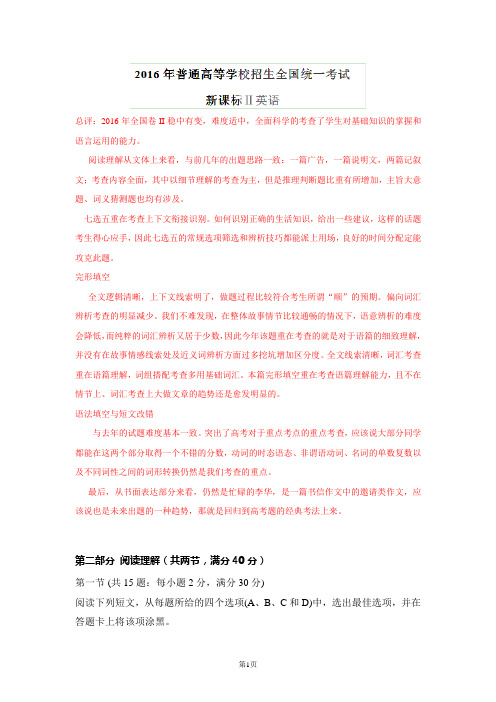
总评:2016年全国卷II稳中有变,难度适中,全面科学的考查了学生对基础知识的掌握和语言运用的能力。
阅读理解从文体上来看,与前几年的出题思路一致:一篇广告,一篇说明文,两篇记叙文;考查内容全面,其中以细节理解的考查为主,但是推理判断题比重有所增加,主旨大意题、词义猜测题也均有涉及。
七选五重在考查上下文衔接识别。
如何识别正确的生活知识,给出一些建议,这样的话题考生得心应手,因此七选五的常规选项筛选和辨析技巧都能派上用场,良好的时间分配定能攻克此题。
完形填空全文逻辑清晰,上下文线索明了,做题过程比较符合考生所谓“顺”的预期。
偏向词汇辨析考查的明显减少。
我们不难发现,在整体故事情节比较通畅的情况下,语意辨析的难度会降低,而纯粹的词汇辨析又居于少数,因此今年该题重在考查的就是对于语篇的细致理解,并没有在故事情感线索处及近义词辨析方面过多挖坑增加区分度。
全文线索清晰,词汇考查重在语篇理解,词组搭配考查多用基础词汇。
本篇完形填空重在考查语篇理解能力,且不在情节上、词汇考查上大做文章的趋势还是愈发明显的。
语法填空与短文改错与去年的试题难度基本一致。
突出了高考对于重点考点的重点考查,应该说大部分同学都能在这两个部分取得一个不错的分数,动词的时态语态、非谓语动词、名词的单数复数以及不同词性之间的词形转换仍然是我们考查的重点。
最后,从书面表达部分来看,仍然是忙碌的李华,是一篇书信作文中的邀请类作文,应该说也是未来出题的一种趋势,那就是回归到高考题的经典考法上来。
第二部分阅读理解(共两节,满分40分)第一节(共15题:每小题2分,满分30分)阅读下列短文,从每题所给的四个选项(A、B、C和D)中,选出最佳选项,并在答题卡上将该项涂黑。
AWhat‟s On?Electric Underground7.30pm-1.00am Free at the Cyclops TheatreDo you know who‟s playing in your area? We‟re bringing you an evening of live rock and pop music from the best local bands. Are you interested in becoming a musician and getting a recording contract(合同)? If so, come early to the talk at 7.30pm by Jules Skye, a successful record producer. He‟s going to talk about how you can find the right person to produce you music.Gee Whizz8.30pm-10.30pm Comedy at KaleidoscopeCome and see Gee Whizz perform. He‟s the funniest stand-up comedian on the comedy scene. This joyful show will please everyone, from the youngest to the oldest. Gee Whizz really knows how to make you laugh! Our bar is open from 7.00pm for drinks and snacks(快餐).Simon‟s Workshop5.00pm-7.30pm Wednesdays at Victoria StageThis is a good chance for anyone who wants to learn how to do comedy. The workshop looks at every kind of comedy, and practices many different ways of making people laugh. Simon is a comedian and actor who has 10 yea rs‟ experience of teaching comedy. His workshops are exciting and fun. An evening with Simon will give you the confidence to be funny.Charlotte Stone8.00pm-11.00pm Pizza WorldFine food with beautiful jazz music; this is a great evening out. Charlotte Stone will perform songs from her new best-selling CD, with James Pickering on the piano. The menu is Italian, with excellent meat and fresh fish, pizzas and pasta(面食). Book early to get a table. Our bar is open all day, and serves cocktails, coffee, beer, and white wine.1. Who can help you if you want to have your music produced?A. Jules Skye.B. Gee Whizz.C. Charlotte Stone.D. James Pickering.2. At which place can people of different ages enjoy a good laugh?A. The Cyclops TheatreB. KaleidoscopeC. Victoria StageD. Pizza World3. What do we know about Simon‟s Workshop?A. It requires membership status.B. It lasts three hours each time.C. It is run by a comedy club.D. It is held every Wednesday.4. When will Charlotte Stone perform her songs?A. 5.00pm-7.30pm.B. 7.30pm-1.00am.C. 8.00pm-11.00pm.D. 8.30pm-10.30pm.【答案】1.A 2. B 3. D 4. C【解析】试题分析:本文属于广告类阅读,介绍了四则广告,难度较小。
2016年高考英语阅读理解、完形填空与语法填空精要解析(新课标I卷)

2016年高考英语(新课标I卷)阅读理解、完形填空、语法填空精要解析从总体上看,2016年高考英语试卷难度略有提升,过渡较为平稳。
试题重点突出,命题思路清晰,重视对思维能力和文化素质的考查,重点考查英语运用能力。
阅读理解与前几年的出题思路一致。
话题贴近学生生活,可读性强。
从体裁上看,稍有变化。
几乎年年出现的应用文今年没有考查。
从题目上来看,细节题居多。
15道阅读题里,1道主旨大意题,1道词义猜测题,2道推理判断题,11道事实细节题。
七选五秉承一贯特色,选用了说明文,结构清晰。
完形填空选自国外网站的一篇文章。
体裁依然是多年的夹叙夹议。
从题目上来看,文章内容看似简单,但选项中“陷阱”重重。
比如第41题应选择C选项traveling,但是很多学生选择了B选项touring,这体现出学生对一些基本词汇的深层含义的掌握是有欠缺的。
认真研究2016年高考英语全国课标I卷,并对阅读理解的每篇文章和完形填空做了详尽的分析,包括语篇的话题、体裁、词数、难度、难点词、搭配、长难句等,并首次运用图式理论从关键词、背景、结构、内容、百科知识的角度分析了语篇,在答案解析部分呈现。
试卷导航第二部分阅读理解(共两节,满分40分)试题略真题分析A语篇导航答案与解析B 语篇导航答案与解析C 语篇导航D 语篇导航答案与解析阅读七选五语篇导航完形填空语篇导航答案与解析语法填空一、真题回顾全国课标I卷阅读下面材料,在空白处填入适当的内容(1个单词)或括号内单词的正确形式。
Chengdu has dozens of new millionaires, Asia’s biggest building, and fancy new hotels. But for tourists like me, pandas are its top 61. attraction (attract).So it was a great honour to be invited backstage at the not-for-profit Panda Base, where ticket money helps pay for research, I 62. was allowed (allow) to get up close to these cute animals at the 600-acre centre. From tomorrow, I will be their UK ambassador. The title will be 63. officially(official) given to me at a ceremony in London. But my connection with pandas goes back 64. to my days on a TV show in the mid-1980s, 65. when I was the first Western TV reporter 66. permitted (permit) to film a special unit caring for pandas rescued from starvation in the wild. My ambassadorial duties will include 67. introducing (introduce) British visitors to the 120-plus pandas at Chengdu and others at a research centre in the misty mountains of Bifengxia.On my recent visit, I held a lively three-month-old twin that had been rejected by 68. its (it) mother. The nursery team switches him every few 69. days (day) with his sister so that while one is being bottle-fed, 70. the other is with mum — she never suspects.全国课标II卷阅读下面材料,在空白处填入适当的内容(1个单词)或括号内单词的正确形式。
2016高考全国卷英语考纲深度解读 复习备考方案高三党必读

2016高考全国卷英语考纲深度解读复习备考方案!高三党必读“新题型”值得关注:取消单项填空题,增加语篇型语法填空;阅读包括了“四选一”和“七选五”的题型。
一、近3年高频考点分析1、2015试题分值2、2013年到2015年各类题型的考点分布 2.1 阅读理解近3年英语阅读理解以细节题和推断题为主;词义推测和主旨大意两类题型考查较少,每年一种题型一道或无。
体裁以记叙文为主,应用文/说明文/议论文基本每年一篇。
做题方法:(1)细节题①略读获取主旨大意;②写下信息词,注意层次结构的词;③查读法(带着问题找答案);④细读。
(2)推断题①文章没有给出明显的事实和依据,让你自己根据文章给出事实进行理解、推断;②做题方法:可用排除法。
2.2 完形填空考查词性频率:名词>动词>形容词>副词>连词。
体裁:记叙文、议论文、夹叙夹议。
其中记叙型完形填空是高考和备考的重点。
2015年选材常用国外网站几年前的文章、选项表意优先,长短其次。
做题技巧:①首句信息:主旨②暗示信息:语境③语篇标志语、逻辑关系词语④原词复现,近义词语2.3 语法填空(2014年由单选题变为语法填空)体裁:短文体,提示词7个,无提示3个。
只填1个词。
如何下手:(1)分析句子结构;(2)结合语境;(3)具体出题形式与答题技巧:①给出动词基本形态,填写词性词形转化(转为名词、形容词),或填写谓语部分,可能需要填写两个或三个词,或是填写非谓语动词;②给出形容词,需要填写比较级、最高级,或词性词形转化,转化为副词,或是填写反义词(前缀);③给出副词,填写比较级、最高级,或是填写反义词;④有提示词考查:谓语动词、非谓语动词、形容词、副词;⑤无提示词考查:冠词、介词、连词、代词。
2.4 短文改错上表显示,近三年全国课标I卷短文改错高频考点为名词单复数、连词、冠词、介词、形容词和副词、动词时态和代词。
出题遵循11815原则:“一删,一填,八改,15个出题点”。
2016年全国统一高考英语试卷(新课标ⅲ)(含解析版)(1)
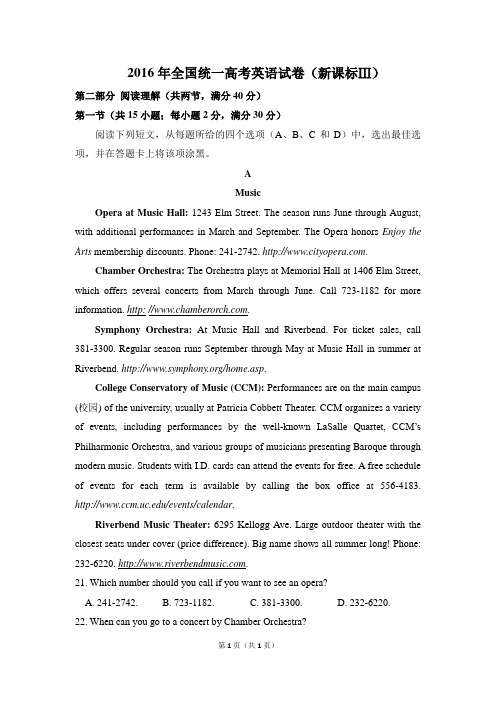
2016年全国统一高考英语试卷(新课标Ⅲ)第二部分阅读理解(共两节,满分40分)第一节(共15小题;每小题2分,满分30分)阅读下列短文,从每题所给的四个选项(A、B、C和D)中,选出最佳选项,并在答题卡上将该项涂黑。
AMusicOpera at Music Hall: 1243 Elm Street. The season runs June through August, with additional performances in March and September. The Opera honors Enjoy the Arts membership discounts. Phone: 241-2742. .Chamber Orchestra: The Orchestra plays at Memorial Hall at 1406 Elm Street, which offers several concerts from March through June. Call 723-1182 for more information. .Symphony Orchestra: At Music Hall and Riverbend. For ticket sales, call 381-3300. Regular season runs September through May at Music Hall in summer at Riverbend. /home.asp.College Conservatory of Music (CCM): Performances are on the main campus (校园) of the university, usually at Patricia Cobbett Theater. CCM organizes a variety of events, including performances by the well-known LaSalle Quartet, CCM’s Philharmonic Orchestra, and various groups of musicians presenting Baroque through modern music. Students with I.D. cards can attend the events for free. A free schedule of events for each term is available by calling the box office at 556-4183. /events/calendar.Riverbend Music Theater: 6295 Kellogg Ave. Large outdoor theater with the closest seats under cover (price difference). Big name shows all summer long! Phone: 232-6220. .21. Which number should you call if you want to see an opera?A. 241-2742.B. 723-1182.C. 381-3300.D. 232-6220.22. When can you go to a concert by Chamber Orchestra?A. February.B. May.C. August.D. November.23. Where can students go for free performances with their I.D. cards?A. Music Hall.B. Memorial Hall.C. Patricia Cobbett Theater.D. Riverbend Music Theater.24. How is Riverbend Music Theater different from the other places?A. It has seats in the open air.B. It gives shows all year round.C. It offers membership discounts.D. It presents famous musical works.BOn one of her trips to New York several years ago, Eudora Welty decided to take a couple of New York friends out to dinner. They settled in at a comfortable East Side cafe and within minutes, another customer was approaching their table.“Hey, aren’t you from Mississippi?” the elegant, white-haired writer remembered being asked by the stranger. “I’m from Mississippi too.”Without a second thought, the woman joined the Welty party. When her dinner partner showed up, she also pulled up a chair.“They began telling me all the news of Mississippi,” Welty said. “I didn’t know what my New York friends were thinking.”Taxis on a rainy New York night are rarer than sunshine. By the time the group got up to leave, it was pouring outside. Welty’s new friends immediately sent a waiter to find a cab. Heading back downtown toward her hotel, her big-city friends were amazed at the turn of events that had changed their Big Apple dinner into a Mississippi state reunion (团聚).“My friends said: ‘Now we believe your stories,’” Welty added. “And I said: ‘Now you know. These are t he people that make me write them.’”Sitting on a sofa in her room, Welty, a slim figure in a simple gray dress, looked pleased with this explanation.“I don’t make them up,” she said of the characters in her fiction these last 50 or so years. “I don’t have to.”Beauticians, bartenders, piano players and people with purple hats, Welty’speople come from afternoons spent visiting with old friends, from walks through the streets of her native Jackson, Miss., from conversations overheard on a bus. It annoys Welty that, at 78, her left ear has now given out. Sometimes, sitting on a bus or a train, she hears only a fragment (片段) of a particularly interesting story.25. What happened when Welty was with her friends at the cafe?A. Two strangers joined her.B. Her childhood friends came in.C. A heavy rain ruined the dinner.D. Some people held a party there.26. The underlined word “them” in Paragraph 6 refers to Welty’s .A. readersB. partiesC. friendsD. stories27. What can we learn about the characters in Welty’s fiction?A. They live in big cities.B. They are mostly women.C. They come from real life.D. They are pleasure seekers.CIf you are a fruit grower — or would like to become one — take advantage of Apple Day to see what’s around. It’s called Apple Day but in practice it’s more like Apple Month. The day itself is on October 21, but since it has caught on, events now spread out over most of October around Britain.Visiting an apple event is a good chance to see, and often taste, a wide variety of apples. To people who are used to the limited choice of apples such as Golden Delicious and Royal Gala in supermarkets, it can be quite an eye opener to see the range of classical apples still in existence, such as Decio which was grown by the Romans. Although it doesn’t taste of anything special, it’s still worth a try, as is the knobbly (多疙瘩的) Cat’s Head which is more of a curiosity than anything else.There are also varieties developed to suit specific local conditions. One of the very best varieties for eating quality is Orleans Reinette, but you’ll need a warm, sheltered place with perfect soil to grow it, so it’s a pipe dream for most apple lovers who fall for it.At the events, you can meet expert growers and discuss which ones will best suit your conditions, and because these are family affairs, children are well catered forwith apple-themed fun and games.Apple Days are being held at all sorts of places with an interest in fruit, including stately gardens and commercial orchards (果园). If you want to have a real orchard experience, try visiting the National Fruit Collection at Brogdale, near Faversham in Kent.28. What can people do at the apple events?A. Attend experts’ lectures.B. Visit fruit-loving families.C. Plant fruit trees in an orchard.D. Taste many kinds of apples.29. What can we learn about Decio?A. It is a new variety.B. It has a strange look.C. It is rarely seen now.D. It has a special taste.30. What does the underlined phrase “a pipe dream” in Paragraph 3 mean?A. A practical idea.B. A vain hope.C. A brilliant plan.D. A selfish desire.31. What is the author’s purpose in writing the text?A. To show how to grow apples.B. To introduce an apple festival.C. To help people select apples.D. To promote apple research.DBad news sells. If it bleeds, it leads. No news is good news, and good news is no news. Those are the classic rules for the evening broadcasts and the morning papers. But now that information is being spread and monitored (监控) in different ways, researchers are discovering new rules. By tracking people’s e-mails and online posts, scientists have found that good news can spread faster and farther than disasters and sob stories.“The ‘if it bleeds’ rule works for mass media,” says Jonah Berger, a scholar at the University of Pennsylvania. “They want your eyeballs and don’t care how you’re feeling. But when you share a story with your friends, you care a lot more how they react. You don’t want them to think of you as a Debbie Downer.”Researchers analyzing word-of-mouth communication — e-mails, Web posts and reviews, face-to-face conversations — found that it tended to be more positive thannegative (消极的), but that didn’t necessarily mean people preferred positive news. Was positive news shared more often simply because people experienced more good things than bad things? To test for that possibility, Dr. Berger looked at how people spread a parti cular set of news stories: thousands of articles on The New York Times’ website. He and a Penn colleague analyzed the “most e-mailed” list for six months. One of his first findings was that articles in the science section were much more likely to make the list than non-science articles. He found that science amazed Times’ readers and made them want to share this positive feeling with others.Readers also tended to share articles that were exciting or funny, or that inspired negative feelings like anger or anxiety, but not articles that left them merely sad. They needed to be aroused (激发) one way or the other, and they preferred good news to bad. The more positive an article, the more likely it was to be shared, as Dr. Berger explains in his new book, “Contagious: Why Things Catch On.”32. What do the classic rules mentioned in the text apply to?A. News reports.B. Research papers.C. Private e-mails.D. Daily conversations.33. What can we infer about people like Debbie Downer?A. They’re so cially inactive.B. They’re good at telling stories.C. They’re inconsiderate of others.D. They’re careful with their words.34. Which tended to be the most e-mailed according to Dr. Berger’s research?A. Sports news.B. Science articles.C. Personal accounts.D. Financial reviews.35. What can be a suitable title for the text?A. Sad Stories Travel Far and WideB .Online News Attracts More PeopleC. Reading Habits Change with the TimesD. Good News Beats Bad on Social Networks第二节(共5小题;每小题2分,满分10分)根据短文内容,从短文后的选项中选出能填入空白处的最佳选项。
2016高考英语全国卷一卷英语含问题详解解析汇报

实用文档2016普通高等学校招生全国统一考试(新课标I)英语试卷类型第Ⅰ卷第一部分听力(共两节,满分30 分)做题时,先将答案标在试卷上,录音内容结束后,你将有两分钟的时间将试卷上的答案转涂到答题卡上。
第一节(共5小题;每小题1.5分,满分7.5分)听下面5段对话,每段对话后有一个小题。
从题中所给的A、B、C三个选项中选出最佳选项,并标在试卷的相应位置。
听完每段对话后,你都有10秒钟的时间来回答有关小题和阅读下一小题。
每段对话仅读一遍。
例:How much is the shirt?A. £19. 15.B. £9. 18.C. £9. 15.C 。
答案是1. What are the speakers talking about?C.B. Doing some exercise. A. Having a birthday party.Getting Lydia a gift.2. What is the woman going to do?C. Get a camera.B. Take a bus.A. Help the man.3. What does the woman suggest the man do?A. Tell Kate to stop.B. Call Kate's friends.C. Stay away from Kate.4. Where does the conversation probably take place?A. In a wine shop.B. In a supermarket.C. In a restaurant.5. What does the woman mean?实用文档A. Keep the window closed.B. Go out for fresh air.C.Turn on the fan.22.5分)第二节(共15小题;每小题1.5分,满分听下面5段对话或独白。
2016届高三二轮复习:新课标高考全国卷考纲解读及历年高考试题对比分析 英语部分

3年高考说明对比最新的2016年高考考试大纲中,有关英语科目的考试要求、考试形式以及试卷结构与2015年考纲内容基本一致,而较之2014年,则有三方面的变化:首先,阅读理解题从要求考生“根据上下文推断生词的词义”变更为“根据上下文推断单词和短语的含义”,这一变化体现了高考中对考查考生理解推断能力的扩展和加强;其次,语法填空题要求填写所需内容的词数要求,由“不多于3个单词”变化为“1个单词”,这意味着考生需更加准确地把握语境内容以及选用恰当的词汇进行作答;最后,词汇量由2500~3500变化为3000~3500,这一变化要求考生需尽量多地掌握考纲要求词汇。
高考备考策略现结合一些实例和同学们谈谈如何进行2016年英语备考。
(一)注重“双基”,夯实基础大多数学生给我提了这么一个问题:“如何在高考英语中取得理想的分数?”我的回答是重视“双基”,夯实基础。
所谓的“双基”是指基础知识和基本能力。
英语的基础知识包括语音、词汇和语法,基本能力涉及听、说、读、写。
那么,如何去夯实基础呢?2. 四种技能,常练不懈我的一个好朋友,翻译家杨先生认为,听、说、读、写这四种技能是相辅相成、互相制约的,如果听说能力不行,读写的水平也不会高到哪里去。
3. 注重语言知识的积累据广西的一个文科状元介绍,她在阅读时十分注意从文章里摘抄好词好句,建立自己的“Vocabulary Bank(词汇库)”,通过亲手抄写的这些语料会逐渐内化为语言能力,在书面表达时会产生笔下生花、信手拈来的美妙效果。
(二)有效学习语法有人说:“没有词汇则没有英语,没有语法则没有正确的英语。
”这句话说明语法的重要性。
(三)要充满智慧地对待英语词汇学习英语词汇是英语学习中最重要的元素,词汇量的大小与英语学习的质量密切相关。
遗憾的是,许多同学到了高三仍没有掌握词汇学习的要领,花在上面的时间虽然不少,词汇学习效率异常低下。
无疑,低效率的词汇学习在一定程度上给自己带来了挫败感,总感觉在英语学习上信心严重不足。
2016英语高考考点考纲解析
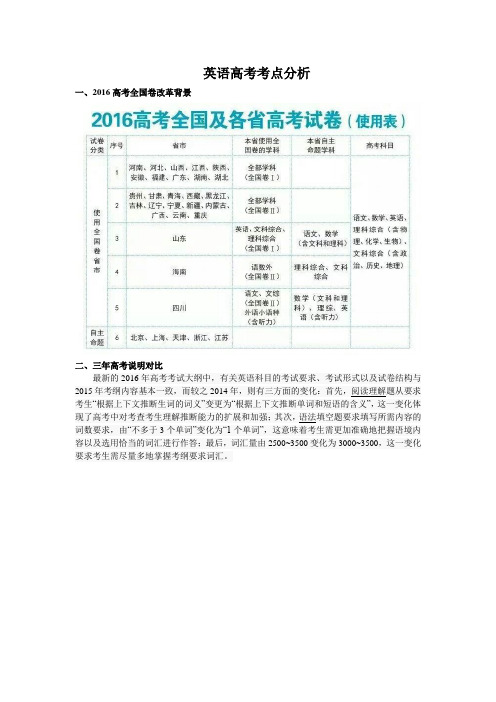
英语高考考点分析一、2016高考全国卷改革背景二、三年高考说明对比最新的2016年高考考试大纲中,有关英语科目的考试要求、考试形式以及试卷结构与2015年考纲内容基本一致,而较之2014年,则有三方面的变化:首先,阅读理解题从要求考生“根据上下文推断生词的词义”变更为“根据上下文推断单词和短语的含义”,这一变化体现了高考中对考查考生理解推断能力的扩展和加强;其次,语法填空题要求填写所需内容的词数要求,由“不多于3个单词”变化为“1个单词”,这意味着考生需更加准确地把握语境内容以及选用恰当的词汇进行作答;最后,词汇量由2500~3500变化为3000~3500,这一变化要求考生需尽量多地掌握考纲要求词汇。
阅读理解:I细节理解词义推测推理判断主旨大意近两年考查数量细节理解推理判断主旨大意词义猜测II•全国I卷阅读稳定为主的趋势;•全国II卷阅读在话题、难度比例方面有调整的需求—话题日常化、A、B篇难度下调,七选五试题选材更符合命题规范、话题更生活化,以避免15届命题的不规范现象。
III近两年考查数量• 同:近三年全国课标I 卷完形填空侧重记叙文体裁,只有一次为纯粹的议论文体裁。
以考查名词和动词为主,虚词仅考查了一次连词。
• 异:15届完形填空体现几方面的突破:选材常用国外网站几年前的文章、选项表意优先,长短其次。
III近两年考查数量• 难度、主要考点保持稳定的趋势; • 形式为短文体的趋势; • 文体为记叙文的趋势;• 较多提示词控制难度的趋势;• 考点轮动(主谓一致、名词单复数、比较级)的趋势。
6222221111近两年考查数量•材料贴近考生学习生活,用学生习作改编的趋势;•通过减少高级考点的考查数量和难度以提升得分率的趋势;•考点轮动(从句轮动热点:定语、状语从句,非谓语动词轮动热点:不定式、过去分词)的趋势。
书面表达:•同:上表显示,近三年全国课标I卷书面表达都为书信体,话题为学生所熟悉,不做开放性要求。
2016年普通高等学校招生全国统一考试大纲 英语
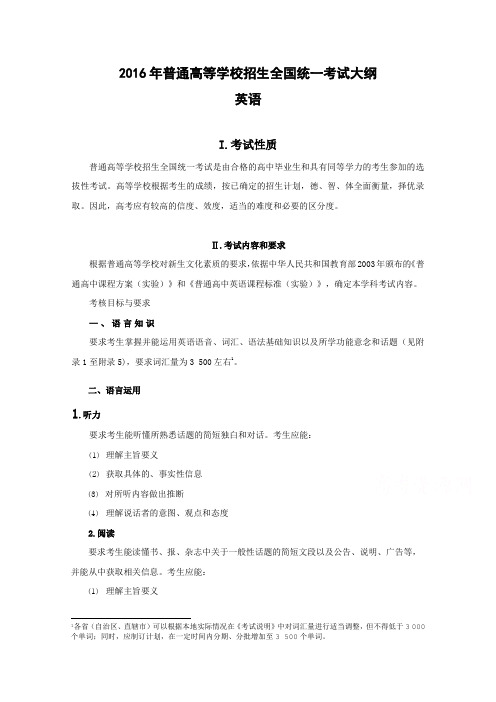
2016年普通高等学校招生全国统一考试大纲英语I.考试性质普通高等学校招生全国统一考试是由合格的高中毕业生和具有同等学力的考生参加的选拔性考试。
高等学校根据考生的成绩,按已确定的招生计划,德、智、体全面衡量,择优录取。
因此,高考应有较高的信度、效度,适当的难度和必要的区分度。
Ⅱ.考试内容和要求根据普通高等学校对新生文化素质的要求,依据中华人民共和国教育部2003年颁布的《普通高中课程方案(实验)》和《普通高中英语课程标准(实验)》,确定本学科考试内容。
考核目标与要求—、语言知识要求考生掌握并能运用英语语音、词汇、语法基础知识以及所学功能意念和话题(见附录1至附录5),要求词汇量为3 500左右1。
二、语言运用1.听力要求考生能听懂所熟悉话题的简短独白和对话。
考生应能:(1)理解主旨要义(2)获取具体的、事实性信息(3)对所听内容做出推断(4)理解说话者的意图、观点和态度2.阅读要求考生能读懂书、报、杂志中关于一般性话题的简短文段以及公告、说明、广告等,并能从中获取相关信息。
考生应能:(1)理解主旨要义1各省(自治区、直辖市)可以根据本地实际情况在《考试说明》中对词汇量进行适当调整,但不得低于3 000个单词;同时,应制订计划,在一定时间内分期、分批增加至3 500个单词。
(2)理解文中具体信息(3)根据上下文推断单词和短语的含义(4)做出判断和推理(5)理解文章的基本结构(6)理解作者的意图、观点和态度3.写作要求考生根据提示进行书面表达。
考生应能:(1)清楚、连贯地传递信息,表达意思(2)有效运用所学语言知识4.口语要求考生根据提示进行口头表达。
考生应能:(1)询问或传递事实性信息,表达意思和想法(2)做到语音、语调自然(3)做到语言运用得体(4)使用有效的交际策略附录1 语音项目表1.基本读音(1)26个字母的读音(2)元音字母在重读音节中的读音(3)元音字母在轻读音节中的读音(4)元音字母组合在重读音节中的读音(5)常见的元音字母组合在轻读音节中的读音(6)辅音字母组合的读音(7)辅音连缀的读音(8)成节音的读音2.重音(1)单词重音(2)句子重音3.读音的变化(1)连读(2)失去爆破(3)弱读(4)同化4.语调与节奏(1)意群与停顿(2)语调(3)节奏5.语音、语调、重音、节奏等在口语交流中的运用6.朗诵和演讲中的语音技巧7.主要英语国家的英语语音差异附录2 语法项目表1.名词(1)可数名词及其单复数(2)不可数名词(3)专有名词(4)名词所有格2.代词(1)人称代词(2)物主代词(3)反身代词(4)指示代词(5)不定代词(6)疑问代词3.数词(1)基数词(2)序数词4.介词和介词短语5.连词6.形容词(比较级和最高级)7.副词(比较级和最高级)8.冠词9.动词(1)动词的基本形式(2)系动词(3)及物动词和不及物动词(4)助动词(5)情态动词10.时态(1)一般现在时(2)一般过去时(3)一般将来时(4)现在进行时(5)过去进行时(6)过去将来时(7)将来进行时(8)现在完成时(9)过去完成时(10)现在完成进行时11.被动语态12.非谓语动词(1)动词不定式(2)动词的-ing形式(3)动词的-ed形式13.构词法(1)合成法(2)派生法(3)转化法(4)缩写和简写14.句子种类(1)陈述句(2)疑问句(3)祈使句(4)感叹句15.句子成分(1)主语(2)谓语(3)表语(4)宾语(5)定语(6)状语(7)补语16.简单句的基本句型17.主谓一致18.并列复合句19.主从复合句(1)宾语从句(2)状语从句(3)定语从句(4)主语从句(5)表语从句20.间接引语21.省略22.倒装23.强调24.虚拟语气附录3 功能意念项目表1.社会交往(Social Communications)(1)问候(Greetings)(2)介绍(Introduction)(3)告别(Farewells)(4)感谢(Thanks)(5)道歉(Apologies)(6)邀请(Invitation)(7)请求允许(Asking for permission)(8)祝愿和祝贺(Expressing wishes and congratulations) (9)提供帮助(Offering help)(10)接受和拒绝(Acceptance and refusal)(11)约会(Makingappointments )(12)打电话(Makingtelephone calls)(13)就餐(Havingmeals)(14)就医(Seeingthe doctor)(15)购物(Shopping)(16)问路(Askingthe way)(17)谈论天气(Talkingabout weather)(18)语言交际困难(Languagedifficulties in communication) (19)提醒注意(Reminding)(20)警告和禁止(Warningand prohibition)(21)劝告(Advice)(22)建议(Suggestions)2.态度(Attitudes)(23)同意和不同意(Agreement and disagreement)(24)喜欢和不喜欢(Likes and dislikes)(25)肯定和不肯定(Certaintyand uncertainty)(26)可能和不可能(Possibility and impossibility) (27)能够和不能够(Ability and inability )(28)偏爱和优先选择(Preference)(29)意愿和打算(Intentions and plans)(30)希望和愿望(Hopes and wishes)(31)表扬和鼓励(Praise and encouragement) (32)责备和抱怨(Blame and complaint)(33)冷淡(Indifference)(34)判断与评价(Judgement and evaluation)3.情感(Emotions)(35)高兴(Happiness)(36)惊奇(Surprise)(37)忧虑(Worries)(38)安慰(Reassurance)(39)满意(Satisfaction)(40)遗憾(Regret)(41)同情(Sympathy)(42)恐惧(Fear)(43)愤怒(Anger)4.时间(Time)(44)时刻(Point of time)(45)时段(Duration)(46)频度(Frequency)(47)时序(Sequence)5.空间(Space)(48)位置(Position)(49)方向(Direction)(50)距离(Distance)6.存在(Existence)(51)存在与不存在(Existenceand Non-existence) 7.特征(Features)(52)形状(Shape)(53)颜色(Colour)(54)材料(Material)(55)价格(Price)(56)规格(Size)(57)年龄(Age)8.计量(Measurement)(58)长度(Length)(59)宽度(Width)(60)高度(Height)(61)数量(Number)9.比较(Comparison)(62)同级比较(Equalcomparison)(63)差别比较(Comparativeand superlative) (64)相似和差别(Similarityand difference)10.逻辑关系(Logicalrelations)(65)原因和结果(Causeand effect)(66)目的(Purpose)11.职业(Occupations)(67)工作(Jobs)(68)单位(Employer)附录4话题项目表1.个人情况(Personalinformation)2.家庭、朋友与周围的人(Family,friendsand people around)3.周围的环境(Personal environments)4.日常活动(Dailyroutines)5.学校生活(Schoollife)6.兴趣与爱好(Interestsandhobbies)7.个人感情(Emotions)8.人际关系(Interpersonalrelationships)9.计划与愿望(Plansand intentions)10.节假日活动(Festivals, holidays and celebrations)11.购物(Shopping)12.饮食(Foodanddrink)13.健康(Health)14.天气(Weather)15.文娱与体育(Entertainmentand sports)16.旅游和交通(Traveland transport)17.语言学习(Languagelearning)18.自然(Nature)19.世界与环境(The world and the environment)20.科普知识与现代技术(Popularscience and modern technology)21.热点话题(Topicalissues)22.历史与地理(Historyand geography)23.社会(Society)文学与艺术(Literatureand art)附录5词汇表Aa(an) artabandon vability nable aabnormal aaboard prep abolish vabortion nabout ad & prep above prep, a & ad abroad adabrupt aabsence nabsent aabsolute aabsorb vabstract a & n absurd a abundant aabuse vacademic a & n academy n accelerate v accent naccept vaccess n & v accessible a accident n accommodation n accompany v accomplish v account n accountant n accumulate v accuracy naccurate aaccuse v accustomed aache v & n achieve v achievement nacid a acknowledge v acquaintance n acquire v acquisition nacre nacross prepact n & vaction nactive aactivity nactor nactress nactual aacute aAD abbrad=advertisement n adapt v adaptation nadd vaddicted a addition n address n adequate aadjustment n administration n admirable aadmire vadmission nadmit vadolescence n adolescent a & n adopt vadore vadult nadvance v & n advantage n adventure nadvertise v advertisement n advice nadvise vadvocate vaffair naffect vaffection nafford vafraid aAfrica nAfrican a & nafter ad, prep & conj afternoon nafterward(s) adagainst prep age nagency n agenda nagent n aggressive a ago adagree v agreement n agricultural a agriculture n ahead adaid n & vAIDS naim n & vair naircraft n airline n airmail n airplane n airport n airspace n alarm n & v album nalcohol n alcoholic a & n algebra nalike adalive aall ad, a & pron allergic aalley nallocate vallow vallowance nalmost adalone aalong ad & prep alongside adaloud adalphabet nalready adalso adalternative a although conjaltitude naltogether ad aluminium(Am aluminum) n always adam v(be)a.m./am, A.M./AM abbr amateur aamaze vamazing a ambassador n ambassadress n ambiguous aambition nambulance n America n among prep amount n & v ample aamuse v amusement n analyse v analysis n ancestor n anchor v & n ancient aand conj anecdote n anger nangle nangry aanimal nankle n anniversary n announce v annoy vannual a another a & pron answer n & vant nAntarctic a antique n anxiety n anxious aany pron & a anybody pron anyhow ad anyone pron anything pron anyway ad anywhere ad apart ad & a apartment n apologize v apology n apparent a appeal v & n appear v appearance n appendix n appetite n applaud v & n apple n applicant n application n apply v appoint v appointment n appreciate v appreciation n approach n & v appropriate a approval n approve vapproximately ad apron narbitrary aarch narchitect n architecture nArctic aare v(be)area nargue vargument narise(arose, arisen) v arithmetic narm n & varmchair narmy naround ad & prep arrange v arrangement narrest varrival narrive varrow nart narticle nartificial aartist nas ad, conj & prep ash nashamed aAsia nAsian a & n aside adask vasleep a aspect n assess v assessment n assist v assistance n assistant n associate v association n assume v assumption n astonish v astronaut n astronomer n astronomy n at prep athlete n athletic a Atlantic a atmosphere n atom nattach v attack v & n attain v attempt v & n attend vattention nattitude nattract vattraction nattractive aaudience naunt nauthentic aauthor nauthority nautomatic aautonomous aautumn navailable aavenue naverage a & navoid vawake(awoke, awoken) v & aaward naware aaway adawesome aawful aawkward aB baby nbachelor nback ad, a & nbackground nbackward(s) adbacon nbacterium(pl bacteria) n bad(worse, worst) a badminton nbag nbaggage nbakery nbalance nbalcony nball nballet nballoon nbamboo nban n & vbanana nband nbandage nbank nbar nbarbecue nbarber nbarbershop nbare abargain n & vbark v & nbarrier nbase nbaseball nbasement nbasic abasis nbasket nbasketball nbat nbath nbathe vbathroom nbathtub nbattery nbattle nbay nBC abbrbe(am, is, are, was, were, being, been) v beach nbean nbean curd nbear 1nbear 2vbeard nbeast nbeat(beat, beaten) v & nbeautiful abeauty nbecause conjbecome(became, become) vbed nbeddings nbedroom nbee nbeer nbefore prep, ad & conj beg vbegin(began, begun) v behalf nbehave vbehaviour(Am behavior) n behind prep & adbeing nbelief nbelieve vbell nbelly nbelong vbelow prepbelt nbench nbend(bent, bent) v beneath prepbeneficial abenefit n & vbent a & nbeside prepbesides prep & adbetray vbetween prepbeyond prepbicycle nbid v & nbike=bicycle nbill nbingo n biochemistry n biography nbiology nbird nbirth nbirthday n birthplace nbiscuit nbishop nbit nbite(bit, bitten) v bitter ablack a & n blackboard nblame n & vblank n & ablanket nbleed vbless vblind ablock n & vblood nblouse nblow(blew, blown) v blue n & aboard n & vbody nboil vbomb n & v bond n & v bone nbonus nbook n & v boom n & v boot nbooth n border n bored a boring aborn a borrow v boss n botanical a botany nboth a & pron bother v bottle n bottom n bounce v bound a boundary n bow v & n bowl n bowling n box nboy nboycott vbrain nbrake n & vbranch nbrand nbrave abravery nbread nbreak(broke, broken) v & nbreakfast nbreakthrough nbreast nbreath nbreathe vbreathless abrewery nbrick nbride nbridegroom nbridge nbrief abright abrilliant abring(brought, brought) vbroad abroadcast(broadcast, broadcast或-ed, -ed) v brochure nbroken abrother nbrown n & abrunch nbrush v & nBuddhism nbudget nbuffet nbuild(built, built) vbuilding nbunch nbungalow nburden nbureaucratic aburglar nburn(burnt, burnt或-ed, -ed) v & nburst vbury vbus nbush nbusiness nbusinessman/woman(pl businessmen/women) n busy abut conj & prepbutcher n & vbutter nbutterfly nbutton n & vbuy(bought, bought) vby prepC cab ncabbage ncafe ncafeteria ncage ncake ncalculate vcall n & vcalm a & vcamel ncamera ncamp n & vcampaign ncan 1(could);can’t=cannot modal vcan 2ncanal ncancel vcancer ncandidate ncandle ncandy ncanteen ncap ncapital ncapsule ncaptain ncaption ncarbon ncard ncare n & vcareful acareless acarpenter ncarpet ncarriage ncarrier ncarrot ncarry vcartoon ncarve vcase ncash n & vcassette ncast(cast, cast) v castle ncasual acat ncatalogue n catastrophe ncatch(caught, caught) v category ncater vCatholic acattle ncause n & vcaution ncautious acave nCD=compact disk nceiling ncelebrate vcelebration ncell ncent ncentigrade acentimetre(Am centimeter) ncentral acentre(Am center) ncentury nceremony ncertain acertificate nchain nchair nchairman/woman(pl chairmen/women) n chalk nchallenge nchallenging achampion nchance nchange n & vchangeable achannel nchant v & nchaos nchapter ncharacter n characteristic a & n charge v & nchart nchat n & vcheap acheat n & vcheck n & vcheek ncheer n & vcheerful acheers intcheese nchef nchemical a & n chemist nchemistry ncheque(Am check) n chess nchest nchew vchicken nchief a & nchild(pl children) n childhood n chocolate nchoice nchoir nchoke n & vchoose(chose, chosen) v chopsticks nchorus nChristian nChristmas nchurch ncigar ncigarette ncinema ncircle n & vcircuit ncirculate v circumstance ncircus ncitizen ncity ncivil acivilian ncivilization nclap vclarify vclass nclassic aclassify vclassmate nclassroom nclaw nclay nclean v & acleaner nclear aclerk n clever aclick v climate n climb vclinic n clock nclone vclose a & ad cloth n clothes n clothing n cloud n cloudy aclub n clumsy a coach ncoal ncoast ncoat ncocoa n coffee ncoin n coincidence n coke ncold a & n collar n colleague n collect vcollege ncollision ncolour(Am color) n & v comb n & vcombine vcome(came, come) v comedy ncomfort ncomfortable a command n & v comment ncommercial acommit vcommitment n committee ncommon a communicate v communication n communism n communist n & a companion ncompany ncompare vcompass ncompensate vcompete vcompetence n competition n complete a & vcomponent n composition n comprehension n compromise v compulsory a computer n concentrate v concept n concern v & n concert n conclude v conclusion n concrete a condemn v condition n conduct v conductor n conference n confident a confidential a confirm v conflict n confuse v congratulate v congratulation n connect v connection n conscience n consensus nconservation n conservative a consider v considerate a consideration n consist v consistent a constant a constitution n construct v construction n consult v consultant n consume v contain v container n contemporary a content 1n content 2a continent n continue v contradict v contradictory a contrary n & a contribute v contribution n control v & n controversial a convenience nconventional a conversation n convey v convince v cook n & v cooker n cookie ncool acopy n & vcorn ncorner n corporation n correct v & a correction n correspond v corrupt a & v cost n & v cosy(Am cozy) a cottage n cotton n & a cough n & v could modal v count v counter n country n countryside n couple n courage n course ncourtyard ncousin ncover n & vcow ncrash v & ncrayon ncrazy acream ncreate vcreature ncredit ncrew ncrime ncriminal ncriterion(pl criteria) n crop ncross n & vcrossing ncrossroads ncrowd n & vcruel acry n & vcube ncubic acuisine nculture ncup ncupboard ncure n & vcurrency ncurriculum ncurtain ncushion ncustom ncustomer ncustoms ncut(cut, cut) v & ncycle vcyclist nD dad=daddy ndaily a, ad & ndam ndamage n & vdamp a & ndance n & vdanger ndangerous adare v & modal vdark a & ndarkness ndash v & ndata ndatabase ndate n & vdaughter ndawn nday ndead adeadline ndeaf adeal ndear adeath ndebate n & vdebt ndecade ndecide vdecision ndeclare vdecline vdecorate v decoration n decrease vdeed ndeep a & addeer ndefeat vdefence(Am defense) n defend vdegree ndelay n & vdelete v & n deliberately ad delicate adelicious adelight ndelighted adeliver vdemand vdentist n department(Dept.) n departure ndepend vdeposit v & ndepth ndescribe v description ndesert v & ndeserve vdesign v & ndesire v & ndesk ndesperate adessert ndestination ndestroy vdetective n determine vdevelop v development ndevote vdevotion ndiagram ndial vdialogue(Am dialog) n diamond ndiary ndictation n dictionary n die vdiet ndiffer v difference n different a difficult a difficulty n dig(dug, dug) v digest vdigital a dignity n dilemma n dimension n dinner n dinosaur n dioxide ndip vdiploma ndirect a & v direction n director n directory n dirty a disability n disabled a disadvantage n disagree v disagreement ndisappear v disappoint v disappointed a disaster n discount n discourage v discover v discovery n discrimination n discuss v discussion n disease n disgusting a dish ndisk=disc n dislike v dismiss v distance n distant a distinction n distinguish v distribute v district n disturb v disturbing a dive vdiverse adivide v division n divorce vdizzy ado(did, done) vdoctor ndocument ndog ndoll ndollar ndonate vdoor ndormitory(dorm) ndot ndouble a & ndoubt n & vdown prep & addownload n & vdownstairs addowntown ad, n & adozen nDr=doctor ndraft n & vdrag vdraw(drew, drawn) vdrawback ndrawer ndream(dreamt, dreamt或-ed, -ed) n & v dress n & vdrill n & vdrink(drank, drunk) vdrive(drove, driven) vdriver ndrop n & vdrug ndrum ndrunk adry v & aduck ndue adull adumpling nduring prepdusk ndust ndustbin ndusty aduty nDVD=digital versatile disk ndynamic adynasty nE each a & proneager aeagle near nearly a & adearn vearth nearthquake neast a, ad & nEaster neastern aeasy aeat(ate, eaten) v ecology nedge nedition neditor neducate v education n educator neffect neffort negg neggplant neither a, conj & ad elder nelect velectric a electrical a electricity n electronic a elegant aelephant nelse ade-mail n & v embarrass v embassy n emergency n emperor nemploy vempty aencourage v encouragement n end n & vending nendless aenemy nenergetic a energy nengine nengineer nenjoy venjoyable a enlarge venough pron, a &ad enquiry nenter venterprise n entertainment n enthusiastic a entire aentrance nentry nenvelope n environment n envy v & nequal a & v equality nequip v equipment neraser nerror nerupt vescape n & v especially ad essay nEurope n European a & n evaluate veven adevening nevent neventually adever adevery a everybody pron everyday a everyone pron everything pron everywhere ad evidence nevident a evolution nexact aexam=examination n examine v example n excellent a except prep exchange n & v excite vexercise n & vexhibition nexist vexistence nexit nexpand vexpect vexpectation nexpense nexpensive aexperience nexperiment nexpert nexplain vexplanation nexplicit aexplode vexplore vexport n & vexpose vexpress v & nexpression nextension nextra aextraordinary aextreme aeye neyesight nFfacial afact nfactory nfade vfail v & nfailure nfair 1afair 2nfaith nfall 1(fell, fallen) vfall 2(Am)=autumn nfalse afamiliar afamily nfamous afan nfancy n, v & afantastic afantasy nfar(farther, farthest或further, furthest) a & ad fare nfarm nfarmer nfast a & adfasten vfat n & afather nfault nfavour(Am favor) nfavourite(Am favorite) a & n fax n & vfear nfeast nfeather nfederal afee nfeed(fed, fed) vfeel(felt, felt) vfeeling nfellow nfemale a & nfence nferry nfestival n & afetch vfever nfew pron & afibre(Am fiber) nfiction nfield nfierce afight(fought, fought) n & v figure n & vfile nfill vfilm n & vfinal afinance nfind(found, found) v。
2016年北京高考英语试题分析与解答word版打印版.doc
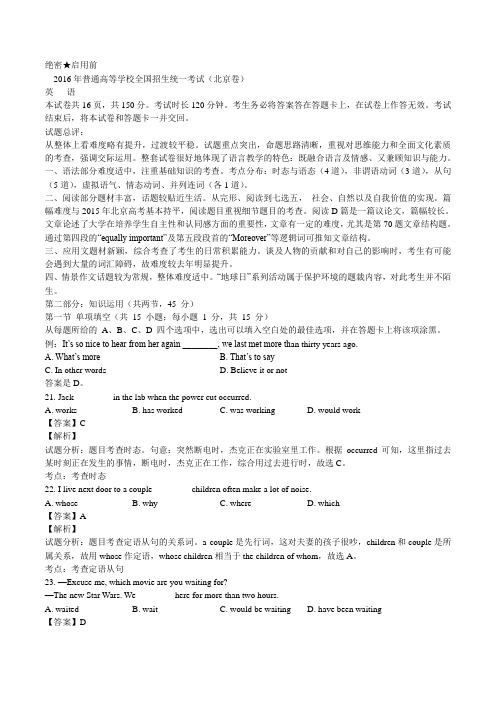
绝密★启用前2016年普通高等学校全国招生统一考试(北京卷)英语本试卷共16页,共150分。
考试时长120分钟。
考生务必将答案答在答题卡上,在试卷上作答无效。
考试结束后,将本试卷和答题卡一并交回。
试题总评:从整体上看难度略有提升,过渡较平稳。
试题重点突出,命题思路清晰,重视对思维能力和全面文化素质的考查,强调交际运用。
整套试卷很好地体现了语言教学的特色:既融合语言及情感、又兼顾知识与能力。
一、语法部分难度适中,注重基础知识的考查。
考点分布:时态与语态(4道),非谓语动词(3道),从句(5道),虚拟语气、情态动词、并列连词(各1道)。
二、阅读部分题材丰富,话题较贴近生活。
从完形、阅读到七选五,社会、自然以及自我价值的实现。
篇幅难度与2015年北京高考基本持平,阅读题目重视细节题目的考查。
阅读D篇是一篇议论文,篇幅较长。
文章论述了大学在培养学生自主性和认同感方面的重要性,文章有一定的难度,尤其是第70题文章结构题。
通过第四段的“equally important”及第五段段首的“Moreover”等逻辑词可推知文章结构。
三、应用文题材新颖,综合考查了考生的日常积累能力。
谈及人物的贡献和对自己的影响时,考生有可能会遇到大量的词汇障碍,故难度较去年明显提升。
四、情景作文话题较为常规,整体难度适中。
“地球日”系列活动属于保护环境的题裁内容,对此考生并不陌生。
第二部分:知识运用(共两节,45 分)第一节单项填空(共15 小题;每小题 1 分,共15 分)从每题所给的A、B、C、D 四个选项中,选出可以填入空白处的最佳选项,并在答题卡上将该项涂黑。
例:It’s so nice to hear from her again ________, we last met more th an thirty years ago.A. What’s moreB. That’s to sayC. In other wordsD. Believe it or not答案是D。
- 1、下载文档前请自行甄别文档内容的完整性,平台不提供额外的编辑、内容补充、找答案等附加服务。
- 2、"仅部分预览"的文档,不可在线预览部分如存在完整性等问题,可反馈申请退款(可完整预览的文档不适用该条件!)。
- 3、如文档侵犯您的权益,请联系客服反馈,我们会尽快为您处理(人工客服工作时间:9:00-18:30)。
命 题 类
主 旨 大 意 型 事 实 细 节 型
词 义 猜 测 型 推 理 判 断 型
一句话说明:这是高考的最高王法! 谁都不能违背!
功能在于说明: 1、考什么? 2、怎么考?
2016高考全国新课标卷英语考试说明和考试大纲 英语考试大纲
要求考生能读懂书、报、杂志中关于一般 性话题的简短文段以及公告、说明、广告等, 并能从中获取相关信息。考生应能: (1)理解主旨和要义 (2)理解文中具体信息 (3)根据上下文推断生词的词义 (4)作出判断和推理 (5)理解文章的基本结构 (6)理解作者的意图、观点和态度
(6)理解作者的意图、观点和态度 英语考试大纲
每篇文章都有一个特定的写作目的,或 是向读者传递某个信息,或是愉悦读者,或是 讲授某个道理。而这些信息通常并不是明确表 达出来,而是隐含在文章之中。因此,这类问 题要求考生在理解文章总体内容的基础上,去 领会作者的言外之意。
因此有关阅读理解题目主要 有以下几种:
(3)根据上下文推断单词和短语的含义 英语考试大纲
正确理解文章中单词或短语的含义是理解文章 的第一步,也是理解文章的基础,不懂单词含义根 本就谈不上理解文章。但英语单词的含义并非完全 等同于词典中所标注的汉语意思,其含义随不同的 语境会有所不同。(注:语境为王)能根据上下文 正确理解灵活变化的词义,才算是真正初步具备了 一定的阅读理解能力。此外,阅读文章时,常常会 遇到一些过去未见过的词,但许多这类生词的词义 可以通过上下文推断出来。这种不使用词典而通过 阅读上下文来推断生词含义的能力,是一个合格的 读者必须具备的能力,因此也是阅读测试中经常检 测的一种能力。
( 2)理解文中具体信息 英语考试大纲
文章主题和中心思想的阐述往往需要大 量细节信息的支持,这些细节对于理解全文内 容至关重要,同时也是归纳和概括文章中心思 想的基础。 命题人员往往会要求考生根据不同的要 求,阅读文章以获得某些特定的信息或准确地 寻求所需的细节。这类试题有时比较直接(注: 直接找),理解字面意思即可答题;有时则较 为间接(注:麻烦一些),需要归纳、概括和 推理才能答题。
(英语考试大纲 5)理解文章的基本结构
英语文章讲究使用主题段和主题句。 主题段通常在文章开头,简要概括文章的中心 思想。 主题句可能在一段的开头,也可能在中间或末 尾,作用是交代该段的中心思想,再由全段展开或 讨论这个意思。 各个段落通常由某些起连接作用的词语连接, 以使文章行文连贯。如果希望准确、深刻地理解一 篇文章,必须对文章的结构有所了解,把握住全篇 的文脉,即句与句、段与段之间的逻辑关系。
(1)理解主旨和要义 英语考试大纲
任何一篇文章都会有一个主旨要义。有 时从文章的第一个段落,甚至第一个句子即可 得出文章的主旨要义,从这一段或这个句子读 者会知道文章描述的是谁或什么(即文章的主 题),亦会了解作者希望读者了解主题方面的 哪些内容。有时,文章的主旨要义则需从文章 的字里行间进行推断。【难度大一些】这类试 题主要考査考生略读文章、领会大意的能力, 它对考生的归纳、概括能力有一定的要求。
Warm u
Reading is everything!
Why?
什么是考试大纲? 英语考试大纲
(2)理解文中具体信息 (3)根据上下文推断生词的词义 (4)作出判断和推理 (5)理解文章的基本结构 (6)理解作者的意图、观点和态度
什么是考试大纲? 英语考试大纲
